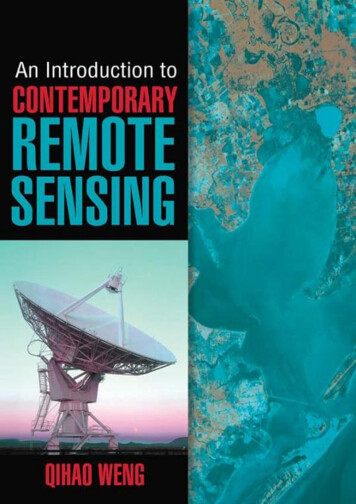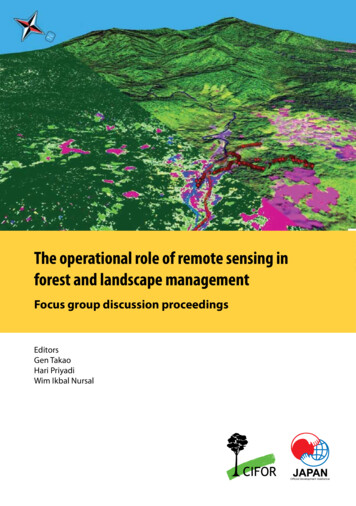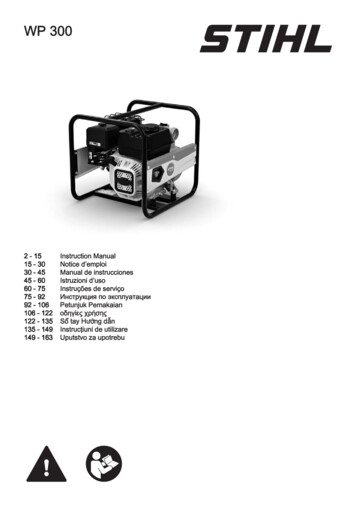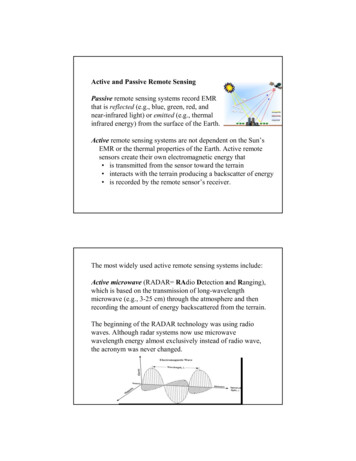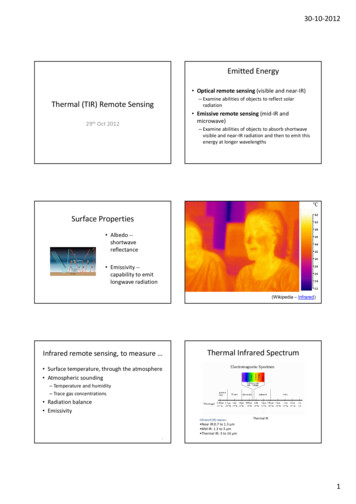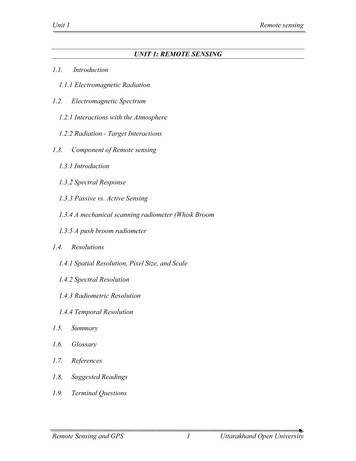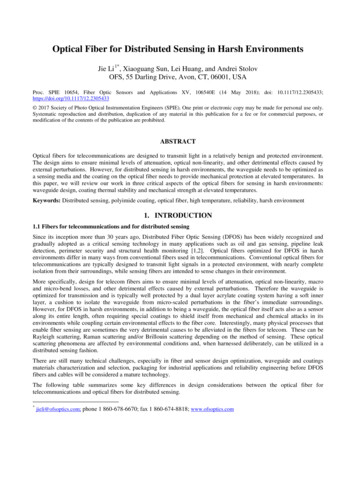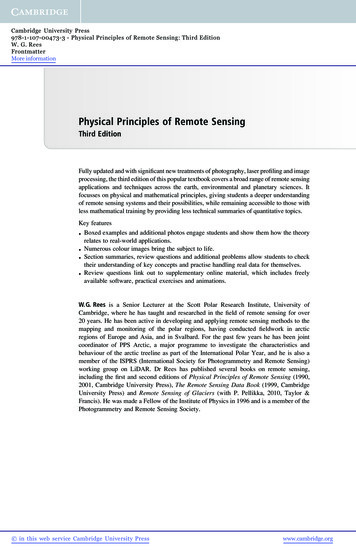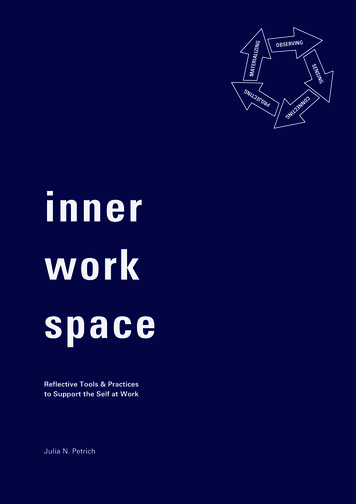
Transcription
GS INSENMATERIALIZINGOBSERVINGCOOPRTINGJulia N. PetrichECReflective Tools & Practicesto Support the Self at WorkNNGTINJECinnerworkspace
INNER WORK SPACEReflective Tools & Practices to Support the Self at WorkA thesis submitted to the School of Design, Carnegie Mellon University,for the degree of Master of Design in Design for --Julia N. Petrich, y Wright Steenson, Advisor 2020 Julia N. Petrich2INNER WORK SPACE
ABSTRACTIn workplaces, especially those that are traditional and hierarchical, the ideasof teamwork, collaboration, communication, trust, and safety have becomecorporate buzzwords. But what do we need as individuals to make thesethings come true in our work lives? How can we collectively create workenvironments that foster these ideals? My intention with this thesis projectwas to explore ways to support the self at work, starting at the base unit of aworkplace community, the individual, and to propose methods and resourcesfor individuals to practice self-reflection in the workplace.Through the course of this project, I investigated theories and frameworksrelated to the self, reflection, and the workplace and applied them to prototypesthat served both as generative research methods and designs to evaluate. Themethods devised and prototypes designed drew on ideas from psychology,sociology, business, spirituality, and other fields related to personal andprofessional growth.The outcome of this thesis is a system of tools called Inner Work Spacethat supports reflection-in-action, reflection-on-action, and reflection-for-action.Ultimately, I aim for Inner Work Space to meet individuals where they are withaccessible tools that assist them in the moment of need and beyond and touse myself as probes to continue to explore this space and expand on thecontributions of this thesis project.4INNER WORK SPACE 5
CONTENTS6INNER WORK SPACEAbstract5Introduction9CONTEXTUALIZING SELF-REFLECTION AT WORK111.1 Understanding the Self131.2 Reflection as a Tool & Practice191.3 In the Workplace231.4 Summary25EXPLORING SELF-REFLECTION AT WORK272.1 Exploratory Research Methods292.2 Insights29GENERATIVE RESEARCH & PRINCIPLES333.1 Generative Research Methods353.2 Design Principles39DESIGN & EVALUATION414.1 Design434.2 Components434.3 Prototyping & Evaluation48Concluding Reflections51References53 7
INTRODUCTIONMany of us experience difficulties navigating the effect that our work andworkday events have on our emotions, our internal lives, as well as on ourability to do our jobs, maintain working relationships. Even when the workdayends, these events can have an effect on our personal lives and relationships.Further, our own experiences then have an effect on others and perpetuatethis cycle, as we find ourselves bringing our issues to work. (See diagram tothe left.)Unlike other solutions that focus on organizational change or developmentof teams and processes, Inner Work Space focuses primarily on individuals andnot just their work performance or satisfaction but their inner lives. It aims tomake change where these individuals have the most control, with themselves.How can we reframe difficult moments at work not as events that happen toEVENTSRESULTSus, where we are powerless to external forces, but instead as circumstancesthat are impacted by our own past experiences and the thought and behaviorpatterns we’ve established throughout our lives? Inner Work Space is aninvitation to unpack the past, take responsibility for our own feelings about ourjobs, and step into a healthier future relationship with work.Research QuestionHow might I support individuals at work in establishing and maintaininga practice of self-reflection in, on, for, and as action?How might I support individuals at work inestablishing and maintaining a practice ofself-reflection in, on, for , and as action?Reflection is, at its core, before anything else, the difference between reactingand responding. When we react, an event happens and a reaction immediatelyfollows. Responding on the other hand builds in a pause after an event. Pausinglike this offers space for consideration on how our actions line up to the kind ofperson or coworker we want to be and gives us the ability to see the situationfrom more than one perspective.When we build the reflective pause into our way of being, that canlook like a practice of self-reflection. And there are three different ways thismight happen:1. Reflection-in-action: pausing in the moment (Schön, 1984)2. Reflection-on-action: thinking through events after the fact,once they are in the past (Dewey, 1936)3. Reflection-for-action: looking forward to how you mightimprove or change for the future (Killion & Todnem, 1991)4. Reflection-as-action: as activity and practice (Farrell, 2018)8INNER WORK SPACE 9
CHAPTERONEcontextualizingself-reflectionat work10INNER WORK SPACE 11
STRATEGYPRODUCTIVITYTRAUMAINFORMEDTHERAPYTEAMSMIND & BODYEMOTIONSLEADERSHIPPSYCHOLOGYSTRESS1.1 UNDERSTANDING THE SELFThis section discusses perspectives on the self: what it is and what it isn't,what it means to be aware of the self and to know it, what it means tohave a true or authentic self, and how individuals can grow more fully intotheir selves.But first, there are many different angles and interpretations on the self.ENHANCINGABSORBINGConsider how many ideas begin with the “self-” prefix. Before we get intothe relevant literature, to understand the relationship between all of thesedifferent dimensions of the self, I’ve synthesized this model to demonstratethe progressive relationship between these ideas that build upon one another:SELF-REFLECTIONAT WORKSUPPORTINGIMPROVINGPERSONAL ousness“I have a self.”Self-observation“I see my self.”Self-awareness“I recognize my self.”Self-knowledge“I understand my self.”Self-acceptance“I release my self.”Self-compassion“I embrace my self.”Self-confidence“I believe in my self.”Self-growth“I transform my self.”PURPOSEMINDSETCREATIVITYDEALING WITHCONFLICTCOMMUNICATIONSPIRITUALITYExperiencing the SelfHow do we experience having a self? First, we may want to describe the self.In Presence: Bringing Your Boldest Self to Your Biggest Challenges, socialpsychologist Amy Cuddy (2018) shares three characteristics of the self:1. It is multifaceted, not singular.2. It is expressed and reflected through our thoughts, feelings,values, and behaviors.3. It is neither static nor rigid. It is dynamic, flexible, and open togrowth.[Figure 1.1]This concept map shows theareas adjacent to self-reflectionat work that this thesis drewupon. How each relates to theself, reflection, and work isexplored in this section.12To the first point, the self is not singular. In fact, it is made up of many parts,all of which are “not just feelings but distinct ways of being, with their ownbeliefs, agendas, and roles in the overall ecology of our lives” (van der Kolk,INNER WORK SPACE 13
2015). We manage our parts through what’s known as “internal leadershipthe implications of our selves in context. Self-awareness is a foundational skillskills—how well we listen to our different parts, make sure they feel taken carefor understanding, monitoring, and improving our emotional lives. Identifyingof, and keep them from sabotaging one another” (van der Kolk, 2015). This“our destructive emotions as they are first stirring” gives us “maximal choicealigns with the idea that very often our worst enemy can be ourselves. Moreabout how we will respond to them” (Goleman, 2004). We will discuss morespecifically, we can face challenges when one or more parts don’t get along oron emotions, reactions, and responses in the coming sections.an internal leader insufficiently negotiates among the parts.We can identify two primary types of self-awareness: internal self-Further, our self-experience is made up of a balance between emotionawareness and external self-awareness. Internal self-awareness involvesand reason. While emotion and reason are not necessarily oppositional, itseeing yourself clearly. This includes understanding what you value, what yourdoes take a good balance between these two parts of our brains to feel likeinterests are, what makes you tick, where you want to be, and what you wantourselves. In average circumstances, these parts are usually able to workto do. Someone with high internal self-awareness knows what they want andtogether relatively well. But in critical situations, especially when survival ismakes choices that are consistent and aligned. Consistency and alignment areat stake, these systems work independently and instinctive action takes over.key features of authenticity, which we will discuss more about later in thisMany of us are able to find balance once we are no longer in danger, and wesection. External self-awareness involves understanding how others see youexperience the self once again. The speed at which we return to ourselvesand being able to see yourself from the outside in. Someone with high externaldepends on how quickly our reactions cool down. (van der Kolk, 2015)self-awareness, being able to see themselves from the perspective of others,As our life circumstances inevitably shift and change throughout our lives,is better at building stronger and more trusting relationships. Those lower inif our sense of self is too rigid, the inflexibility of the self can get in the wayinternal self-awareness may find themselves doing things that don’t matchof our well-being. Being able to adapt to change is critical to our long-termup to their beliefs and desire; those low in external self-awareness may gethappiness, peace, and even survival. If we consider that the self is usuallyshocked by feedback from others, if they ever hear it. (Eurich, 2018)associated with the body, it becomes even more evident that a rigid sense ofself is not ideal, as our bodies grow and change regularly throughout our lives.Self Knowledge (Or, Knowing Thyself)Buddhist psychology brings us the idea of “no-self” which supports theseOnce we are able to recognize ourselves, at what point do we know ourselves?points. “No-self” does not mean we’re no one or don't experience a self. ItIn Good Business, Mihaly Csikszentmihalyi (2004) explains that there aremeans that our self isn’t fixed and is a part of everything around it. (Germer &multiple (but equally valid) ways to go about self-knowledge. He describesSalzberg, 2009)two generalized paths one can take: the philosopher’s path and that of theThe self is experienced from both the outside in and the inside out.business leader. Philosophical thinkers are more likely to view self-knowledgeTo experience the self, we need to have consciousness of it. There areas a lifelong project in which the goal is the end. Business leaders on the othercircumstances in which we forget the self, and there other other times whenhand tend to view a journey to self-knowledge as a means rather than an end.our awareness of the self becomes magnified. As individuals, we have a strongTheir goal is to “act effectively in the world,” and self-knowledge is how theyconcern for the self. So much so, that when engrossed in a task, if we hearbegin to do that. Csikszentmihalyi explains that instead of endlessly searchinga reference to ourselves, our attention will be drawn to the self (we becomelike the thinkers, these business leaders look for a “core belief that can sustainself-conscious), and we are pulled away from the task at hand. It doesn’tthem through life.” When they come across a belief (usually borrowed frommatter if the reference is critical or praising or anything in between. (Csikszent-their upbringing, religious background, or culture) that instinctively seems right,mihalyi, 2004)they tend to go with it and carry on.Is one approach better than the other? It likely depends on the individual.14The Implications of Self-AwarenessSome might find the philosopher’s journey more meaningful; others might seeHow do we define the distinction between the consciousness of the selfit as a tiresome slog. Some might find the business leader’s journey moreand self-awareness? While self-consciousness is the moment in which weimmediately impactful and freeing in the way it adds value quickly; others mightremember the existence of the self, self-awareness is “the ability to seesee it as vacuous or surface-level. Different paths will be better for differentourselves clearly —to understand who we are, how others see us and how weindividuals, possibly at different seasons of their lives. No matter which path isfit into the world around us” (Eurich, 2018). Clearly is the operative word here.chosen, it’s still hard work, which requires reflection. We will discuss more onBeyond simply taking note of our “selves,” self-awareness brings us clarity onthat in the following section on reflection.INNER WORK SPACE 15
The Authentic Self Is a State of Beingbecome” (Brown, 2010). We can define self-acceptance as “recognizing whatWhen describing what it means for the self to be true, we may be temptedis happening inside us, and regarding what we see with an open, kind andto imagine authenticity as a quality. Either someone is authentic or not, fullloving heart” (Brach, 2004).stop. While authenticity is many things, it is not a feature that exists or doesSelf-compassion is the next step. Compassion itself involves “thenot exist. While this means the work of “being authentic” is never done, itrecognition and clear seeing of suffering” as well as “kindness for people whoalso means that we all exist on a continuum of authenticity. Even if we haveare suffering, so that the desire to help—to ameliorate suffering—emerges”a bad day or two, those days do not make us inauthentic people. Authenticity(Neff, 2015). With self-compassion, we turn that kindness toward ourselves.is, as many other states of being, “a conscious choice of how we want toSelf-acceptance and self-reflection are courageous acts when you considerlive” (Brown, 2010). We make these choices everyday, and eventually we maythe context of a culture of people-pleasing that oftentimes promotes puttingestablish a practice of authenticity.ourselves last.The authentic self, as a state of being, is flexible, not static. In conjunctionwith purpose, a practice of authenticity “allows us to connect the events of ourSelf-Confidence & Presencepast to who we are now, and who we are becoming” (Craig, 2018). AuthenticityThis specific type of confidence in the self that stems from awareness andplays an important role in our continual process of becoming as individuals.acceptance is far from representations of cockiness or arrogance that weThrough practice, we find ourselves “letting go of who we are supposed to bemight otherwise think of. In her book, Dare to Lead, Brene Brown (2018) callsand embracing who we are” (Brown, 2010).this grounded confidence: “the messy process of learning and unlearning,practicing and failing, and surviving a few misses.” This can also be referredSynchronous, Differentiated, & Integratedto as presence.When we practice authenticity, we find ourselves coming into alignment. InPresence is “the state of being attuned to and able to comfortably expressthese instances when we are in a state of authenticity, all facets of the selfour true thoughts, feelings, values, and potential” (Cuddy, 2018). It grows outare in harmony. There is consonance between what is going on inside us (ourof feelings of personal power, sincerity, and authenticity. In her book Truethoughts, emotions, beliefs, and values) and outside (our actions, behaviors,Refuge, Tara Brach (2016) describes presence as “intrinsic to our nature” andwords, and expressions). If what we do is not consistent with what we believe,as “immediate and embodied.” She lays out three components of presence:we feel inauthentic. If we do not reflect our genuine feelings in our expressionswe do not feel like our true selves. (Cuddy, 2018)How can we develop a self that feels synchronous and coherent? And1. Wakefulness: consciousness to what is going on around usand within us, including our body sensations and thoughtswhat does it look like? By establishing and maintaining a consistent set of2. Openness: recognizing and allowing without evaluatinggoals, individuals can create order in their experience “which manifests itself in3. Tenderness: sensitivity, warmth, and responsivenesspredictable actions, emotion, and choices,” and “in time becomes recognizableas a more or less unique ‘self’” (Csikszentmihalyi, 1998).Brach explains that while these three can be referred to as qualities ofDifferentiation and integration work together to form a self that feelspresence, they are inseparable, like a sunlit sky: the light of consciousness,true and appropriately complex. The realization of the uniqueness of self, asthe wide openness of the sky, and the warmth of the sun. No one element canpreviously described, is referred to as the process of differentiation. Integration,exist without the other two.on the other hand, allows us to see that our selves are reliant on and embedded16in networks of other humans: our relationships, our communities, our culturalSelf-Growth & Mindsetassociations, and our environments. We have the best chance at having a lifeOne way to describe self-growth is “an erratic forward movement: two stepsthat contains happiness, meaning, and authenticity when we work towardsforward, one step back” (Cameron, 2016). Here’s another description, given byboth differentiation and integration. (Csikszentmihalyi, 2004)Jane Fonda, as quoted in Good Business (Csikszentmihalyi, 2004):Acceptance & CompassionPeople are capable, including myself, of perpetual change and growth. It’sAcceptance of and compassion for the self work hand in hand. “The betterthe one thing in the entire universe that goes counter to the second law ofwe are at accepting ourselves and others, the more compassionate wethermodynamics—entropy—everything descends into decay. EverythingINNER WORK SPACE 17
spirals downward, rots and decays, except the human spirit, which has the1. Downloading past patternscapacity to grow and to evolve upward.2. Seeing with fresh eyes3. Sensing from the fieldGrowth is not a linear process, but there are models and frameworks we4. Presencing/connecting to the sourcecan use to understand how self-growth and change happen. First, what is the5. Crystallizing vision and intentiondifference between a growth and fixed mindset? People with a fixed mindset6. Prototyping the new by linking the head, heart, and the handare likely to believe that intelligence is static. Their desire to appear smart7. Performing by operating from the wholeleads to a tendency to avoid challenge, get defensive or give up, and ignorefeedback. They can also end up feeling threatened by others and believing thatAlthough Theory U is primarily intended for use with groups and teamsany effort they put in is in vain. Those with a growth mindset, on the otherwithin organizations, it still has relevance as a reflective process. This and otherhand, are likely to believe that intelligence can be developed. Their desire toreflective processes for change expose the value of reflection in innovating orlearn leads to a tendency to embrace challenge, persist, learn from criticism,making change in the world. Whether reflection is happening in group settingsget inspired by the success of others, and work hard on a path to mastery.or by individuals alone, the steps overlap across these frameworks.Those with a growth mindset are afforded the opportunity to ‘become’ whichGOALSHABITSDESIREDOUTCOMEmay be preferable to the existence of someone with a fixed mindset, whoBEHAVIORSTHAT SUPPORTYOUR VISIONdoesn’t believe in that luxury. (Dweck, 2007)Mindset is the foundational element of achievement and fulfillment. NoDOWNLOADINGpast patternsPERFORMINGfrom the wholegrowth is possible without believing it to be possible. The behaviors that supportMINDSETFOUNDATION OFACHIEVEMENT &FULFILLMENTyour vision build upon that and work toward the goal or desired outcome. (SeeFigure 1.2)SEEINGwith fresh eyesPROTOTYPINGthe newFrameworks for Change[Figure 1.2]The Creative Pyramid (Jarvis, 2019)In the next section, we will discuss reflection as a tool and practice. But beforesee withnew eyespractice that I want to call attention to here. The first is “The Spiral of the Work”go forthCRYSTALLIZINGvision & intentionSENSINGfrom the fieldthat, there are two frameworks for growth and change that relate to reflectivePRESENCINGfrom the Work That Reconnects. The spiral is a journey with four stages:[Figure 1.4]Theory U (Scharmer & Senge, 2016)1. Coming from Gratitude2. Honoring our Pain for the Worldhonor our painfor the worldcome fromgratitude[Figure 1.3]The Spiral of the Work (Macy & Brown, 2014)3. Seeing with New Eyes4. Going Forth.Gratitude is an opportunity to quiet the mind and center ourselves. When wehonor our pain, we experience it and accept it, and on top of that, seeing with1.2 REFLECTION AS A TOOL & PRACTICEAt its core, reflection is a tool and a practice that helps us scale from selfconsciousness ("I have a self") to self-growth ("I transform my self").The first step to reflection is the pause, which delays and/or stops reactionnew eyes allows us to observe, sense, and make connections. Finally, goingcompletely, allowing for response. Effectively building these kinds of pausesforth is taking (new) action. This process is reflective, as it allows for stillness,into our daily lives becomes a reflective practice.connection, and sensing before any actions are taken. The process may also befractal and repeated at different scales. (Macy & Brown, 2014)Learning to PauseSimilar to the spiral, Otto Scharmer’s (Scharmer & Senge, 2016) TheoryIn Radical Acceptance, Tara Brach defines the pause as “a suspension ofU is another well-known framework for change. It contains these main steps/activity, a time of temporary disengagement when we are no longer movingelements:toward any goal” (Brach, 2004). While there are times when reaction isnecessary for survival (or we wouldn’t have reactions at all), there are many18INNER WORK SPACE 19
times and ways in which we can build these pauses into our daily lives.Through pausing, we are able to listen and communicate coming from a placeUnderstanding that not every situation is a crisis and that we are allowed theof presence and compassion. (Brach, 2004)space to pause is the first step.Rumination Is Not ReflectionBrach explains that a pause is time-limited by nature. Eventually we goback to our activities, but the pause brings us more presence and confidenceThe key to reflection is focusing on the present. Rumination, on the other hand,and increases our ability to make choices. She explains the value of the pause:focuses on the past and the future. This tends to happen when we jump to“We free ourselves at ground level from the reactivity that perpetuates ourconclusions about cause and effect, rather than focusing on the elements ofsuffering” (Brach, 2004).the situation we are in. (Fosslien & Duffy, 2019)Psychologist Martin Seligman has called attention to “three P’s” that wetend to focus on after a negative event: Personalization (“It’s all my fault”),Pervasiveness (“This will ruin everything”), and Permanence (“I’m going tofeel like this forever”). Reflection bypasses these negative thought patterns.EVENT(Seligman, 2006)REACTA PRACTICE OFSELF-REFLECTIONNoting Emotions in the BodyWhile many conceptualize emotions as part of our minds, they are alwaysexpressed in the body, more consistently and regularly in the body. In fact,it can be a helpful reflective tool to identify where in the body we are feelingEVENT[Figure 1.5]The role of the pausePAUSERESPONDour emotions and how they affect our bodies. This kind of body awarenesscan help de-escalate even the most intense emotions. Even simply labelingyour emotions within your body, giving them names as simple as anger, fear,sadness, etc. is an excellent grounding tool for the ruminating mind. (Germer& Salzberg, 2009)Waking from Trance into PresenceRelated to the ruminating mind is the idea of trance. This symbol createdEVENTby Joseph Campbell (Figure 1.7) expresses the relationship betweenREACTconsciousness and unconsciousness. The line represents the distinctionA PRACTICE OFSELF-REFLECTIONbetween what we are conscious of and what is outside of our consciousawareness. When we are living below the line, we’re in trance, unaware of thelarger reality of our existence and experience. Becoming self-aware and livingEVENTPAUSEin presence, we emerge above the line. (Brach, 2019)RESPONDThese are some of the characteristics as laid out by Brach (2019):[Figure 1.6]Pausing in practicePresenceunconscious—below the lineconscious—above the lineasleep, in a dreamwakeful, lucid, awarecaught or possessed by emotionsemotions witnessed mindfullyopens up our options. The alternative, which many of us live with, is beingdissociatedin contact with feelingsdriven by the unconscious emotions and needs which manifest in our reactions.heart defended or numbheart caring and tenderPausing is a choice. We can hold back from saying something in reaction,reactive to experiencesresponsive to experiencesand we can name the inner thoughts and sensations that are affecting us.grasping or resistingbalanced, open, and discerningPracticing pausing and paying close attention to our minds and bodies20TranceINNER WORK SPACE[Figure 1.7]Joseph Campbell's Circle of Awareness(Brach, 2019) 21
To move from trance to presence, Brach promotes a reflective tool known asRAIN (Recognize, Allow, Investigate, Nurture).1.3 IN THE WORKPLACEHow do all of these ideas of the self and reflection fit into a work context? In aShedding Negative Self-BeliefsAll of us have experienced negative self-beliefs. These are related to thediagram related to the concept of generative team design, Dara Blumenthal(2016) demonstrates how the outcomes of innovation and change that manyenemies within who tell us who we are, who perceive the self with judgment,organizations and teams are trying to achieve stem from adult developmentalcynicism, and fear. Reflection helps us understand that these negativecapacity, which I define as related to a growth mindset: wanting to grow,self-beliefs are just that: “beliefs not facts” (Cameron, 2016).knowing we can, and having the resources to begin. Self-awareness andAs quoted in Radical Compassion (Brach, 2019), Nietzsche wrote, “Theself-reflection build upon this idea.[Figure 1.8]From Blumenthal (2016)snake that cannot shed its skin perishes.” This means that in order to continueon living a life that is fulfilling and meaningful, we need to let go over negativeAttitudes on Workbeliefs that tell us something is wrong with us and that have never servedIf we had the chance, many of us would spend less time onus well. As our emotions, these self-beliefs can be found embedded in thework. This is true for two reasons. The first is related to thebody. The first steps are realizing that these beliefs are “real but not true” andconditions of work, which lead many of us to believe that wecritically viewing our inner voices and thoughts. (Brach, 2019)can’t have a good time at work. The second is the culturaland historical understanding of work that many of us inherit.Modes of ReflectionTogether, those two reasons make it difficult for many of usWhat is reflection? Reflection is the activity that helps us learn. As Johnto admit that work can be fun. (Csikszentmihalyi, 1998)Dewey (1936) explained, as “[w]e do not learn from experience. we learnWe may have an attitude of resentment toward ourfrom reflecting on experience.” This reflection-on-action takes place after anjobs because it seems pointless to us, not doing anyoneevent happens. In his book The Reflective Practitioner, Schön (1984) buildsany good, or worse, doing harm. We may overcome this byupon Dewey with the concept of reflection-in-action which takes advantage offinding ways to add meaning or value to our work. Anotherthe pause in the middle of action. Reflection is taken to the next step, whenreason may be that the work is boring or routine and lackswe consider reflection-for-action (Killion & Todnem, 1991) which is reflectioninherent opportunities for growth. Overcoming this relateson future actions, intending to improve or change a practice, behavior, pattern,back to understanding that growth is our journey, it’s on usetc. Further, reflection-as-action (Farrell, 2018) acknowledges that reflectionto uncover opportunities that may not initially be apparent.itself is a practice that one can incorporate into their life.Additionally, another problem is stress, especially relatedif you want.Innovationthen you need.Teamworkexperience that we may be able to work through withThree skills are known as the tripod of reflection: openness, observation, andself-reflective practices. These attitudes of resentmentobjectivity. Openness suggests that we are receptive to what we come acrossare obstacles within our control. While family, history, andand are no longer clinging to what we believe things “should” be. It allows ussociety have played a part in shaping these attitudes, if ourto see things clearly, for what they actually are, instead of through the lens ofwork is meaningless, stressful, and dull, it is within our handsour beliefs. Observation is how we perceive ourselves and the context in whichto overcome it. (Csikszentmihalyi, 1998)Power at WorkReflection at its core requires that we stay open, observant, and objective asConsidering control, a related concept is the idea of power.we perceive what’s going on inside and outside of us. (Siegel, 2010)In her book Dare to Lead, Brene Brown (2018) calls attentiont
CONTEXTUALIZING SELF-REFLECTION AT WORK 11 1.1 Understanding the Self 13 1.2 Reflection as a Tool & Practice 19 1.3 In the Workplace 23 1.4 Summary 25 EXPLORING SELF-REFLECTION AT WORK 27 2.1 Exploratory Research Methods 29 2.2 Insights 29 GENERATIVE RESEARCH & PRINCIPLES 33 3.1 Generative Research Methods 35 3.2 Design Principles 39
